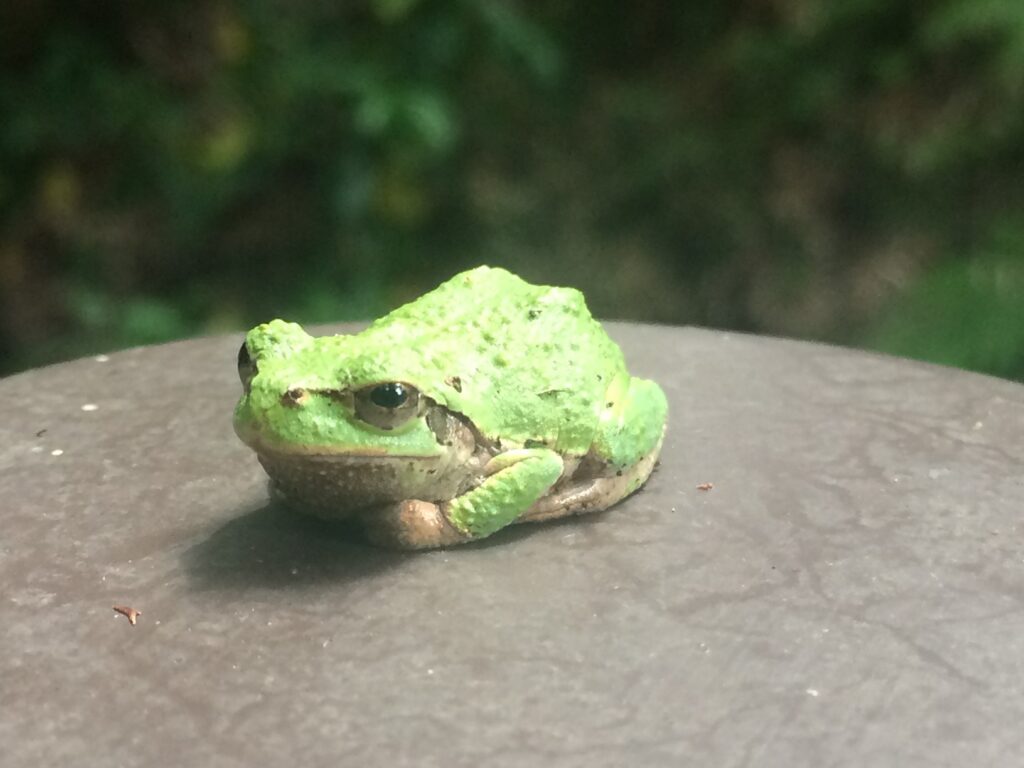Today is a good day, is my thought, observing the shades of green on the mountain slopes through the panoramic window at KULM, a simple-yet-sophisticated vegan eatery in the quaint village of Ohara, nestled in between the rice paddies and mountains that protect Kyoto from the northern winds and spirits. Yuka and I had arrived by bus from Kokusaikaikan station earlier in the morning, which is supposed to be the fastest way out of the city by public transport. My memories of Ohara were of a charming-but-crowded rural getaway. Instead, on this weekday morning, the small road leading up to the iconic Sanzen-in temple is almost devoid of human presence and the souvenir shops are still closed. Small freshwater crabs can be spotted along the stream running down the roadside and a tree frog, the Kaeru, sits on a pole as if on a throne, the undisputed king of his own microcosm, just like a character in a Miyazaki animé.

Skipping the visit of Sanzen-in this time, we turn back and follow the signs leading to the temple of Jakko-in, in the lower part of the village. A short walk southwards along the rice fields brings us alongside carp streamer banners, on display for Children’s Day. We follow the Kyoto Trail, which heads into Ohara from the slopes of Mount Hiei. Our intention is to go for a short walk through the forest and a northern Kyoto settlement, heading for the village of Kurama, well known for both its mountain temple and hot spring with outdoor bath, Kurama Onsen, which will be our final reward for today.

The trail soon disappears into the forest, winding up towards a mountain pass. Red-bodied dragonflies are dancing in the sunshine, sitting on fresh green leaves, known in Japanese as shinryoku. We can’t get enough of observing them. At this stage, the trail is never far from signs of civilization, though a sign warns us of the potential presence of black bears. We pass a few wooden cabins in the forest, maybe weekend homes for Kyotoites who would only have to travel a few kilometers from the city. We head out into Kitayama, the northern mountains which embrace Kyoto in a long arc. Towards the west is the Shinto Atago-San and on the eastern side the Buddhist mountain Hieizan. Small statues of Tanuki-San, the frivolous figure of folklore, line the track.

The trail descends the mountain into the small hamlet of Kurama, a popular destination for daytrips out of the city. Most people come to visit Kurama-dera, the mountain temple where reiki has its origins. From the platform in front of the temple, we admire the lush scenery of the mountain valley. The contrast between the yellow-green of the fresh spring leaves, the deep blue sky, and the red painted ceilings is poignant. Japan is truly ‘the empire of the senses’. From here, a mountain trail goes further up Kurama Mountain and then down to the settlement of Kibune, famous for its restaurant decks over a cooling stream. We opt instead to head down to the village of Kurama, on the outskirts of which is the hot spring and its outdoor bath. Soaking in the hot rotenburo and enjoying the view of the surrounding forest is surely a worthy reward for our splendid spring walk. Today is a good day, indeed.


